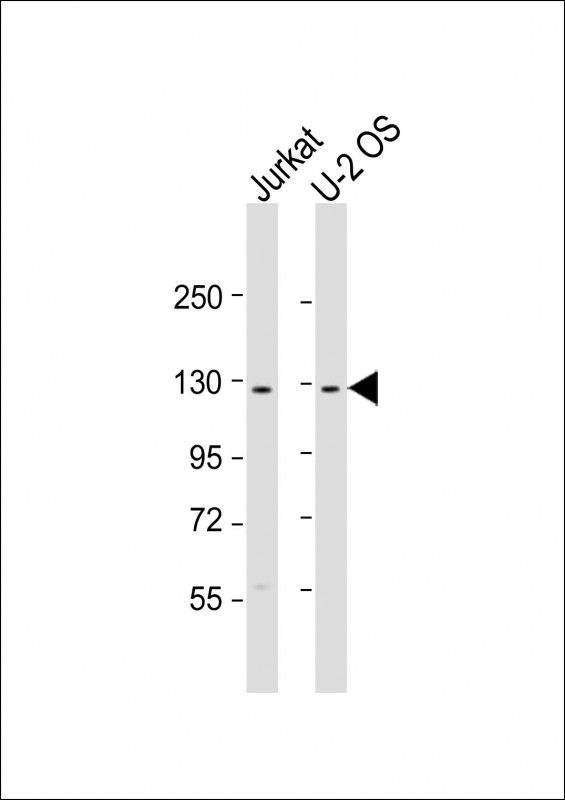CENTG1 Antibody (C-term)
Affinity Purified Rabbit Polyclonal Antibody (Pab)
- SPECIFICATION
- CITATIONS
- PROTOCOLS
- BACKGROUND

Application
| WB, E |
|---|---|
| Primary Accession | Q99490 |
| Other Accession | Q8CGU4, Q3UHD9, NP_001116244.1, NP_055585.1 |
| Reactivity | Human, Mouse |
| Predicted | Rat |
| Host | Rabbit |
| Clonality | Polyclonal |
| Isotype | Rabbit IgG |
| Calculated MW | 124591 Da |
| Antigen Region | 850-877 aa |
| Gene ID | 116986 |
|---|---|
| Other Names | Arf-GAP with GTPase, ANK repeat and PH domain-containing protein 2, AGAP-2, Centaurin-gamma-1, Cnt-g1, GTP-binding and GTPase-activating protein 2, GGAP2, Phosphatidylinositol 3-kinase enhancer, PIKE, AGAP2, CENTG1, KIAA0167 |
| Target/Specificity | This CENTG1 antibody is generated from rabbits immunized with a KLH conjugated synthetic peptide between 850-877 amino acids from the C-terminal region of human CENTG1. |
| Dilution | WB~~1:2000 E~~Use at an assay dependent concentration. |
| Format | Purified polyclonal antibody supplied in PBS with 0.09% (W/V) sodium azide. This antibody is purified through a protein A column, followed by peptide affinity purification. |
| Storage | Maintain refrigerated at 2-8°C for up to 2 weeks. For long term storage store at -20°C in small aliquots to prevent freeze-thaw cycles. |
| Precautions | CENTG1 Antibody (C-term) is for research use only and not for use in diagnostic or therapeutic procedures. |
| Name | AGAP2 |
|---|---|
| Synonyms | CENTG1, KIAA0167 |
| Function | GTPase-activating protein (GAP) for ARF1 and ARF5, which also shows strong GTPase activity. Isoform 1 participates in the prevention of neuronal apoptosis by enhancing PI3 kinase activity. It aids the coupling of metabotropic glutamate receptor 1 (GRM1) to cytoplasmic PI3 kinase by interacting with Homer scaffolding proteins, and also seems to mediate anti-apoptotic effects of NGF by activating nuclear PI3 kinase. Isoform 2 does not stimulate PI3 kinase but may protect cells from apoptosis by stimulating Akt. It also regulates the adapter protein 1 (AP-1)-dependent trafficking of proteins in the endosomal system. It seems to be oncogenic. It is overexpressed in cancer cells, prevents apoptosis and promotes cancer cell invasion. |
| Cellular Location | [Isoform 1]: Cytoplasm. Nucleus. |
| Tissue Location | Isoform 1 is brain-specific. Isoform 2 is ubiquitously expressed, with highest levels in brain and heart |

Thousands of laboratories across the world have published research that depended on the performance of antibodies from Abcepta to advance their research. Check out links to articles that cite our products in major peer-reviewed journals, organized by research category.
info@abcepta.com, and receive a free "I Love Antibodies" mug.
Provided below are standard protocols that you may find useful for product applications.
Background
GTPase-activating protein (GAP) for ARF1 and ARF5, which also shows strong GTPase activity. Isoform 1 participates in the prevention of neuronal apoptosis by enhancing PI3 kinase activity. It aids the coupling of metabotropic glutamate receptor 1 (GRM1) to cytoplasmic PI3 kinase by interacting with Homer scaffolding proteins, and also seems to mediate anti-apoptotic effects of NGF by activating nuclear PI3 kinase. Isoform 2 does not stimulate PI3 kinase but may protect cells from apoptosis by stimulating Akt. It also regulates the adapter protein 1 (AP-1)-dependent trafficking of proteins in the endosomal system. It seems to be oncogenic. It is overexpressed in cancer cells, prevents apoptosis and promotes cancer cell invasion.
References
Shiba, Y., et al. J. Cell. Sci. 123 (PT 14), 2381-2390 (2010) :
Zhu, Y., et al. J. Biol. Chem. 284(20):13489-13496(2009)
Cai, Y., et al. Cancer Res. 69(3):819-827(2009)
Tang, X., et al. Nat. Cell Biol. 10(6):698-706(2008)
Liu, R., et al. Proc. Natl. Acad. Sci. U.S.A. 105(21):7570-7575(2008)
If you have used an Abcepta product and would like to share how it has performed, please click on the "Submit Review" button and provide the requested information. Our staff will examine and post your review and contact you if needed.
If you have any additional inquiries please email technical services at tech@abcepta.com.













 Foundational characteristics of cancer include proliferation, angiogenesis, migration, evasion of apoptosis, and cellular immortality. Find key markers for these cellular processes and antibodies to detect them.
Foundational characteristics of cancer include proliferation, angiogenesis, migration, evasion of apoptosis, and cellular immortality. Find key markers for these cellular processes and antibodies to detect them. The SUMOplot™ Analysis Program predicts and scores sumoylation sites in your protein. SUMOylation is a post-translational modification involved in various cellular processes, such as nuclear-cytosolic transport, transcriptional regulation, apoptosis, protein stability, response to stress, and progression through the cell cycle.
The SUMOplot™ Analysis Program predicts and scores sumoylation sites in your protein. SUMOylation is a post-translational modification involved in various cellular processes, such as nuclear-cytosolic transport, transcriptional regulation, apoptosis, protein stability, response to stress, and progression through the cell cycle. The Autophagy Receptor Motif Plotter predicts and scores autophagy receptor binding sites in your protein. Identifying proteins connected to this pathway is critical to understanding the role of autophagy in physiological as well as pathological processes such as development, differentiation, neurodegenerative diseases, stress, infection, and cancer.
The Autophagy Receptor Motif Plotter predicts and scores autophagy receptor binding sites in your protein. Identifying proteins connected to this pathway is critical to understanding the role of autophagy in physiological as well as pathological processes such as development, differentiation, neurodegenerative diseases, stress, infection, and cancer.



